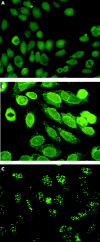Prevalence and clinical significance of isotype specific antinuclear antibodies in primary biliary cirrhosis
- PMID: 15753539
- PMCID: PMC1774444
- DOI: 10.1136/gut.2003.036558
Prevalence and clinical significance of isotype specific antinuclear antibodies in primary biliary cirrhosis
Abstract
Background: Antinuclear antibodies (ANA) giving a rim-like/membranous (RL/M) or a multiple nuclear dot (MND) pattern are highly specific for primary biliary cirrhosis (PBC). Aim and
Subjects: To assess the prevalence of PBC specific ANAs, their Ig isotype, and their clinical significance in 90 PBC patients from Greece and Spain. Twenty eight patients with chronic hepatitis C, 23 patients with systemic lupus erythematosus, and 17 healthy subjects were studied as controls.
Methods: PBC specific ANA reactivity was tested by indirect immunofluorescence using HEp2 cells as substrate and individual Ig class (IgG, IgA, IgM) and IgG subclass (IgG1, IgG2, IgG3, IgG4) specific antisera as revealing reagents.
Results: Fourteen of 90 (15.6%) PBC patients had PBC specific ANA reactivity when an anti-IgG (total) antiserum was used as the revealing reagent while 58 (64.4%) were positive when specific antisera to each of the four IgG isotypes were used. The prevailing isotype was IgG3 for MND and IgG1 for RL/M. PBC patients with specific ANA, in particular of the IgG3 isotype, had significantly more severe biochemical and histological disease compared with those who were seronegative. None of the controls was positive.
Conclusions: Disease specific ANA are present in the majority of patients with PBC when investigated at the level of immunoglobulin isotype. PBC specific ANA, in particular of the IgG3 isotype, are associated with a more severe disease course, possibly reflecting the peculiar ability of this isotype to engage mediators of damage.
Figures


References
-
- Neuberger J. Primary biliary cirrhosis. Lancet 1997;350:875–9. - PubMed
-
- Bogdanos DP, Baum H, Vergani D. Antimitochondrial and other autoantibodies. Clin Liver Dis 2003;7:759–77. - PubMed
-
- Vergani D, Bogdanos DP. Positive markers in AMA-negative PBC. Am J Gastroenterol 2003;98:241–3. - PubMed
-
- Szostecki C, Guldner HH, Will H. Autoantibodies against “nuclear dots” in primary biliary cirrhosis. Semin Liver Dis 1997;17:71–8. - PubMed
-
- Courvalin JC, Worman HJ. Nuclear envelope protein autoantibodies in primary biliary cirrhosis. Semin Liver Dis 1997;17:79–90. - PubMed
